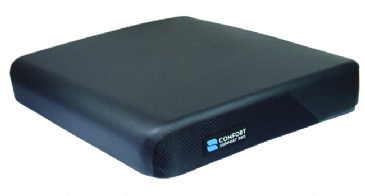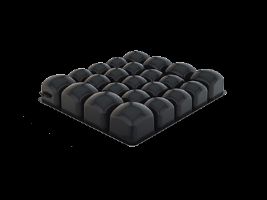 Written by Brittany Ferri, OTR/L
Written by Brittany Ferri, OTR/L
Pressure ulcers, or bedsores, are a big health challenge. This is especially true for wheelchair users, who spend long periods sitting. Understanding preventive measures and effective management strategies is crucial for individuals and caregivers. Luckily, you can find many pressure relief cushion options to reduce the risk of developing pressure ulcers.
 | 1) ROHO Mosaic Air Wheelchair Cushion View Product |
Wheelchair cushions are not one size fits all. To be effective at relieving pressure, they must meet specific criteria, including being of an appropriate size, material, and durability.
If your cushion is too large, it will not fit on the seat of your wheelchair. In this case, it places you at a greater risk of falling by slipping out of the chair. If your cushion is too small, parts of your seat will be uncovered, and your body will spill over the sides. If this happens, you will likely have trouble sitting upright and cannot assume an ergonomic posture. This may lead to injury from an asymmetrical body posture. Measure the size of your seat both length and width, and purchase a cushion that closely meets those specifications.
The material speaks to the cushion’s effectiveness. Cushions made of foam or gel are usually best suited for individuals at a low to medium risk of pressure sores. If someone is at a high risk of developing a pressure sore, they should seek cushions made of more than one material. The best one for this population is partially made of gel and also filled with air.
Various cushions have different capacities based on their style and the material used. Be sure to get a cushion that can withstand your body weight. If your weight fluctuates, getting a higher capacity cushion is best so you will still be protected.
If the person using the cushion struggles with incontinence, they should opt for a cushion with a spill-proof, removable, washer-friendly cover. If you want more cushions on hand, you can also purchase separate cushions for easier replacement and cleaning.
Yes, Roho cushions help prevent ulcers by distributing pressure evenly across many divots in the cushion.
Yes, the main intent of pressure relief cushions is to relieve pressure and improve circulation in a person’s backside when they are seated. Pressure relief cushions are known to be effective for this purpose, but they are just one way someone can redistribute pressure on their skin.
A high-risk cushion is a pressure relief cushion intended to provide superior pressure relief for people at a higher risk of developing bedsores. It is made with two types of materials, most often gel and air sacs.
When someone sits down, much pressure is placed directly on the ischial tuberosities, or the bones underneath the buttocks. If someone is consistently seated for a large portion of the day, as is often the case with people who use wheelchairs, the pressure put on these areas is more likely to cause skin breakdown.
Pressure relief cushions for wheelchairs use materials and mechanisms such as air, foam, and gel to evenly distribute the pressure on a person’s skin. Wheelchair pressure relief cushions spread the force on a person’s bony prominences evenly across the entire area of the seat, lowering their risk for injury by allowing the skin to breathe.
As long as your doctor provides documentation that states a Roho cushion is medically necessary, insurance will often pay for the majority of a Roho cushion. Specifically, Medicare will pay 80% of the cushion, and the patient will be responsible for the remaining 20% of the cost.
An airflow cushion offers greater breathability and air circulation within the cushion itself. Most other cushions, especially foam ones, can trap air and make the user hotter.
A seat sling is a mesh device that simultaneously cradles someone and straps them in to allow easy transport to and from the chair. Seat slings are usually used in combination with mechanical lifts, which hoist someone out of bed or a chair and into a wheelchair. These are also called Hoyer lifts and are ideal for bedridden people who are unable to move to assist with this transfer.
 | Drive Medical Gel-U-Seat Lite 2 Wheelchair Cushion with Waterproof Cover for General Use View Product |
As our number 5 option for ulcer prevention, the Gel-U-Seat Lite 2 Wheelchair Cushion by Drive Medical provides comfort and pressure redistribution. This cushion is designed with a high-density foam core and a dual-chamber gel bladder that conforms to the user's body. It helps to maintain skin integrity and prevent pressure ulcers. The soft, low-shear cover is waterproof and reduces friction, ensuring the cushion remains in place. This cushion will keep the user comfortable throughout the day.
 | Express Comfort Foam Wheelchair Cushion by Comfort Company View Product |
Ranked as our number 4 choice, the Express Comfort Foam Wheelchair Cushion by Comfort Company is designed for individuals who spend long periods seated. This high-density foam cushion provides exceptional comfort and pressure redistribution, significantly reducing the risk of pressure sores and related injuries. The Solace fabric outer cover is fluid-proof, antimicrobial, and breathable. Perfect for optimal hygiene and temperature regulation. This cushion accommodates a wide range of patients with multiple sizes and thickness options.
 | Support Pro 7 Series - Bariatric Cushion by Comfort Company View Product |
As our number 3 pick, the Support Pro 7 Series Bariatric Cushion by Comfort Company provides superior comfort and protection for bariatric users. It can accommodate weights up to 750 pounds. Its non-contoured surface and waterfall front facilitate easier transfers while eliminating leg pressure points. The cushion’s dual layers of high-resiliency foam and optional QuadraGel packs ensure effective pressure redistribution and temperature regulation. The antimicrobial, fluid-resistant Solace fabric cover adds to its durability and hygiene, making it an ideal choice for daily use.
 | ROHO AirLITE Wheelchair Cushion - Foam and Air View Product |
The AirLITE Wheelchair Cushion by Roho Group utilizes a combination of air and foam to make a high-end seating device. Most cushions made purely of foam can flatten quickly. And if they have no backup material to take over, people will feel less and less comfortable when using them. This cushion utilizes the power of air to offer more well-rounded comfort to people who need to relieve back-side pressure.
 | ROHO Mosaic Air Wheelchair Cushion View Product |
Our top choice, the Mosaic Wheelchair Cushion by ROHO Group is one of the most highly regarded pressure relief cushions by therapists. This is because it’s an incredibly effective way to prevent pressure sores in high-risk patients. The Roho Mosaic is still lightweight, comfortable, and highly convenient. The hand pump even allows people to maintain upper body strength by inflating the cushion to their personal and medical preferences.
These are just a few options for those needing pressure relief cushions. Consider weight capacity when shopping for your own, as some cushions support up to 200 pounds while others handle 300 pounds or more. Material is also crucial for both comfort and effectiveness. For high-risk users, cushions combining gel and air sacs are ideal, while foam suits those at low to medium risk. Among the cushions discussed, the Roho Mosaic stands out for high-risk users due to its intricate design and multiple air pockets, offering superior airflow and comfort. However, finding the cushion that best meets your personal and medical needs is essential.
Thanks for reading! We hope you found this article helpful. Feel free to browse our entire selection of wheelchair cushions or check out our blog, Caregiver University for more informative articles.

Brittany is an occupational therapist who has worked in a variety of rehab facilities. She has always expressed an interest in patients’ internal motivation for therapy and the use of assistive devices, which led her to pursue a PhD in Integrative Mental Health. This research-based training has also led her to develop her writing career to educate patients of all ages on how to improve their health. Brittany has published four books, written over 300 articles, and has been quoted in media outlets such as WebMD, Healthline, and NBC News.